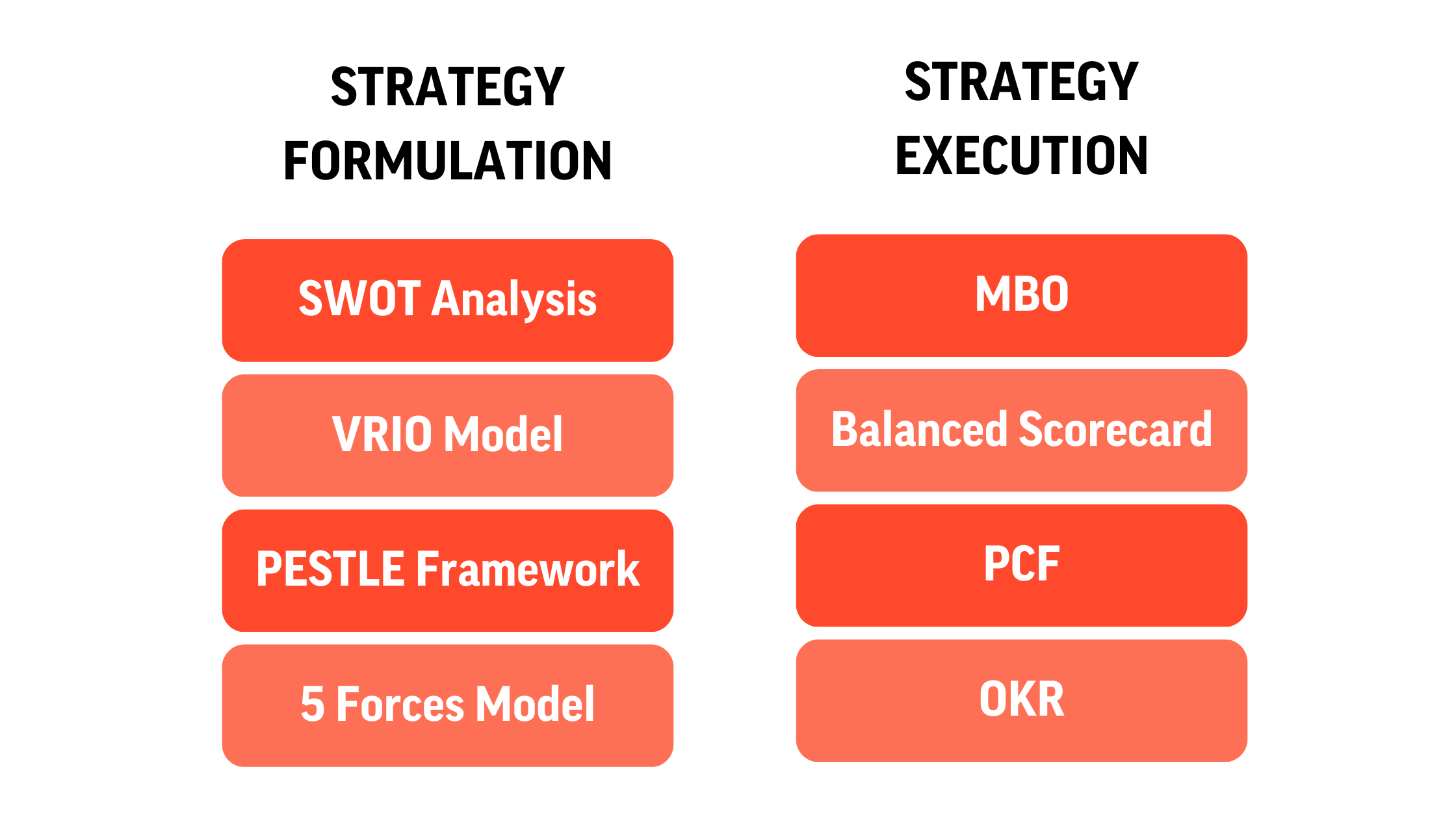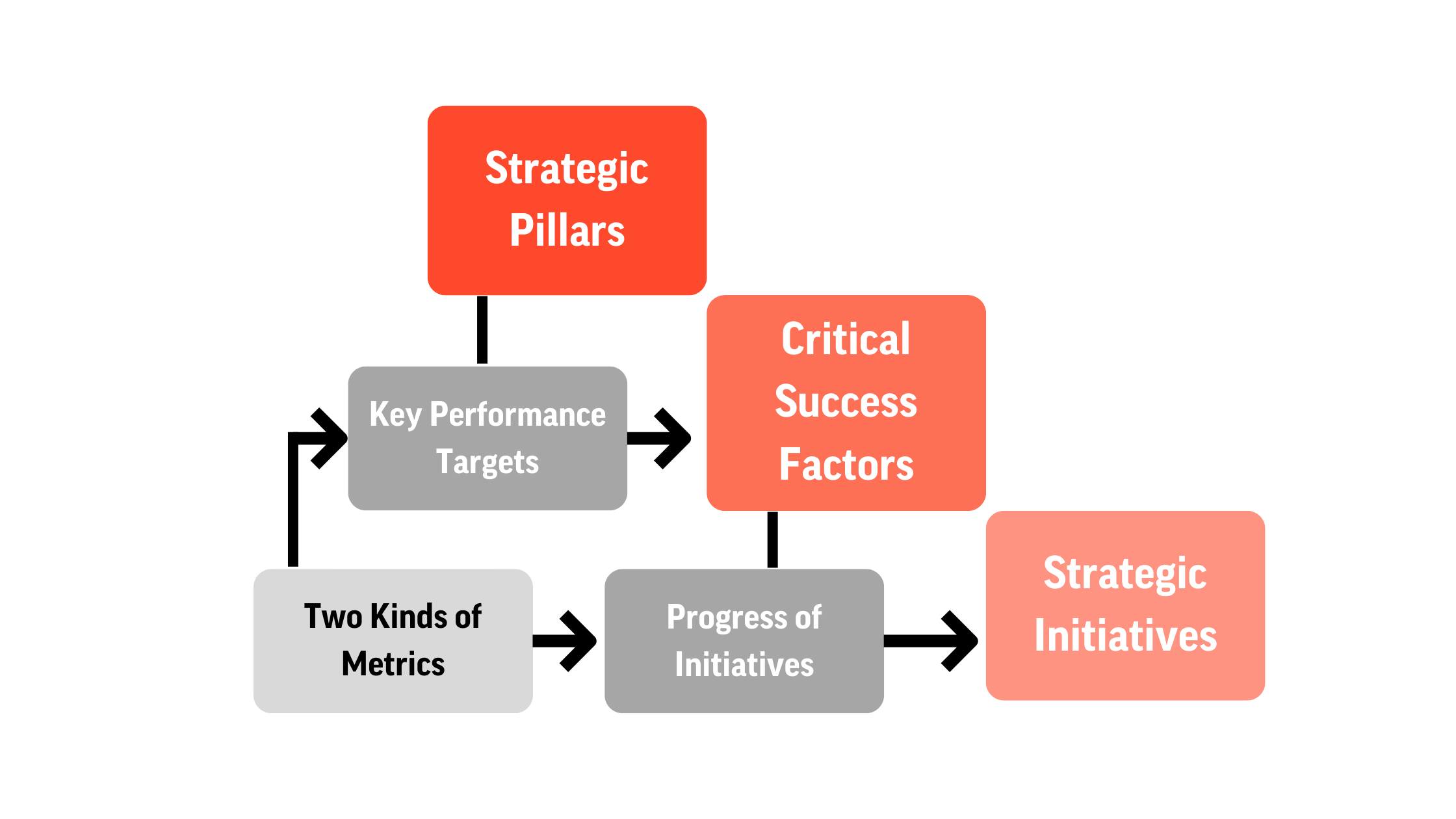How do you manage your Strategic Performance?

In today’s Volatile, Uncertain, Complex and Ambiguous world, the way leaders manage their strategy process becomes ever more important. Yet as this importance grows, we are still faced with the gloomy picture painted by research, that three out of four strategies tend to provide fewer results than planned or even outright fail. Some are never really carried out as such but remain just as high level visionary documents without any intention to execute accordingly. In this article we will outline some strategy models and concepts that have been most commonly used over the years. The intention is to point to a simple and straightforward process useful for managing your strategy on-the-go in times of rapid and fundamental change.
In his book, ‘Strategy, Bad Strategy’, Richard Rumelt stated the simple truth about Strategic Performance Management; “The core of strategy work is always the same: discovering the critical factors in a situation and focusing actions to deal with those factors”.
Relating to Rumelt’s statement, the strategy management process can be divided into two main parts:
- Strategy Formulation - about discovering the critical factors in a situation, and
- Strategy Execution - relating to focusing actions to deal with those factors.
Over time scholars and practitioners have developed and published various models for guidance and assistance in strategic planning activities. All these models are designed to provide structure to the strategy process. It is important when considering these models that they are intended for each part of the process. While some are helping clarify the strategic performance choices and formulating a clear strategic vision, other models provide structure to the strategic intent making the strategy viable to execute.
In this article we will outline some of the most important models for each part so you can better understand when these models or tools are appropriate. However, it is important to bear in mind that the two parts of the strategy process are increasingly merging. With the speed of changes in the modern environment, strategy is formulated on-the-go, thereby transforming the strategic performance process into an Agile Process where trial and error play an essential role.
To master the process throughout, the organisation requires simple tools and techniques everyone can understand and relate to. This will make sure the chosen methodology gets used within the whole organisation, since the different models use different language and names for similar concepts that will create confusion over terminology and disturb the process as a whole.

Strategy Formulation
Below we outline some commonly used models to perform a quick strategic performance management analysis. The intention is to outline brainstorming and deliberation frameworks that might simplify the required analysis, given that it often needs to be quick, simple and involving people with insight in times of rapid change. There are of course numerous models available, many of which serve the same purpose, but the ones we have chosen are fairly common, well documented and cover the main areas of analysis necessary for formulating a strategy. Not all participants might be fully versed in doing strategic performance management analysis, hence a simple method is required to bring everyone to the same page.
Formulating a good strategy is based on accurate diagnosis of the organisation on one hand and analysing external factors on the other hand. The so-called SWOT analysis (Strengths, Weaknesses, Opportunities and Threats) is widely used as an organised framework for brainstorming on both internal and external factors, categorising the points and deliberating on them. The framework is easy to relate to and gives a quick overview. However it has to be considered that there is a very thin line between the SWOT, where one factor can in itself be a strength, opportunity, or even weakness and a threat can be an opportunity, depending on the standpoint from which it is looked at. Furthermore one has to realise that there is often a cause and effect relationship between the different factors. What needs to be added in the deliberation process is putting the SWOT assessment in context with internal and external dynamics.
The internal diagnosis detects the issues or opportunities that are controllable by the organisation and these are often put into the context of the organisation being a living system. This means, there are predictable matters which determine the maturity of the organisation to deal with certain strategic performance management issues. This gives context to what one can expect from the organisation in particular circumstances and its capability to carry out change given different levels of complexity. Dr. Ichak Adizes has developed an extensive framework to understand the organisation in this way, which he describes in his book ‘Managing Corporate Lifecycles’.
When discussing the strengths, identifying Core Competencies is very useful. Strengths can be determined as something unique and difficult to imitate (Core Competencies) on one hand and on the other hand strengths that constitute a competitive advantage, not necessarily sustainable, or even just a strength that does not give a certain advantage as such, but maybe crucial in the strategic efforts of the organisation. Analysing Core Competencies is based on the parameters that they are something unique the organisation has developed over time - often unconsciously. The competencies must have customer value and be difficult and costly to imitate. A specific framework called the VRIO Model is designed to assist in analysing the nature of different strengths or advantages as mentioned above. As with applying any other models, specific care should be taken not to overestimate the strengths. By definition, Core Competencies are not many, maybe just one or perhaps a maximum of two or three, while competitive advantages and general strengths can be more numerous.
Considering external factors such as opportunities and threats, a useful brainstorming technique is the PESTLE framework. This categorises external change factors into Political, Economic, Social, Technical, Legal and Environmental factors. It is useful to collect thoughts and categorise them instantly in order to better understand the nature of the different points being raised. It helps deliberating on each major factor at the time with proper analysis that can give an accurate account of the major change factors facing the organisation.
Here as well, change factors need to be put into context, especially with respect to external market dynamics. In that, the competitive analysis based on the Michael Porter’s Five Forces Model, becomes very useful in that it helps discover the different forces that can shape success of strengthening a market position or entering a new market. One should be careful though, not using it blindly to determine whether to enter or exit a market. The real strength of this model lies in the fact that it can help develop what to change and how to succeed.
When combining the findings of the above dimensions, a balanced picture can be outlined covering the main aspects of what might be the most important things to deal with and how that should be visible in the strategy of the organisation. How to deal with them comes with the execution part, where is it important to keep in mind that in order to equip the organisation to successfully implement a strategy, it will have to involve moving the organistaion as a whole, not just part of it.
Strategy Execution
At best, the general intentions developed through the Strategy Formulation Process defines in a clear manner WHAT is most important and WHY. However, for the strategy to be executable, it will have to be translated into actions and success measurements if there is to be any chance of dealing with the question of HOW to go forward with success. This transforms the strategy into execution and in that process will have to be framed in a way that relates to the whole organisation. In this context, line of sight of all employees becomes critical. It needs to be clear to everyone: How they can contribute to making this strategy successful. Furthermore, progress and success need to be monitored and transparent to everyone and regularly communicated.
In 1954, Peter Drucker introduced the model of Management by Objectives (MBO) in his book: ‘The Practise of Management’. In many ways MBO can be considered the predecessor of many strategic performance management models or tools that have followed. We will briefly outline a few below. The MBO model introduced a methodology to transform organisational objectives into individual objectives based on joint plan between employee and supervisor followed by action, measurement of success and regular review. In his book Drucker also introduced the concept of SMART objectives or goals, and thereby laid the foundation for performance oriented strategy execution management.
in the 1970’s, scholars and practitioners started to enhance the MBO way of thinking. Robert Kaplan and David Norton introduced a breakthrough methodology with their Balanced Scorecard (BSC) approach, which provided a more structured approach to cascading the strategy throughout the organisation. Since then numerous similar structural approaches have been developed and applied. Apart from the BSC approach we will shortly describe the Objectives and Key Results (OKR) methodology as well as a couple of others.
In general these methods can be called tools for managing the strategic performance process all the way to execution. The purpose of of these tools is in essence the following:
- Clarify the role and objectives of every employee relating to the strategy
- Enable Strategic Leadership at every level
- Create clear line of sight leading to shared understanding of the organisation’s goals and objectives
- Align resources and performance indicators to the organisation’s goal at all levels of the organisation
- Engage employees in setting goals, targets and priorities and act on them
These tools each have their distinctive terminology and differ to an extent in how they structure the various elements of the strategy. It can also slightly differ from one organisation to another how these tools are applied. It is not possible to judge whether one tool is superior to another, they all serve the same purpose more or less and the success in using them depends on not the tools themselves, but on the way they are deployed throughout the organization with consistency and resilience. This is what strategic leadership is all about. If not properly used these tools will fail to deliver the desired results.
Balanced Scorecard (BSC) defines different dimensions or perspectives to clarify specific focus areas in the strategy. The perspectives are fixed and to be applied as a standard first layer in the strategy structure: Financial perspective, Customer/stakeholder perspective, internal processes perspectives and learning and growth perspective. The structure is then comprised of different layers under each perspective which, generally speaking, are comprised of the following:
- Objectives: Major strategic objectives to be achieved. Usually stated in qualitative terms, but with a measure attached to it to monitor the performance.
- Measures: The performance indicators used to measure progress in reaching the objective.
- Targets: The specific target value or desired quantitative end result desired for each measure
- Initiatives: Projects and tasks necessary to strive towards the objective and it’s target.
Balance scorecard then assumes certain interrelationships between objectives within different perspectives, where the chain of causality goes vertically from learning and growth, to internal processes to customers and stakeholders ending in the desired financial result. Interrelationships can of course also be vertical between objectives within the same perspective. The most common pitfalls of the BSC tool is the tendency to escalate objectives and measures making it more difficult to maintain line of sight. With traditional ways of reviewing progress manually through Excel or similar spreadsheet solutions, the escalation has resulted in an overly cumbersome procedure which limits the possibilities of engaging employees. Modern digital tools to monitor the process of strategies have however accommodated for this overall problem.
Pillars and Critical Factors (PCF) was developed by DecideAct, a provider of Strategy Execution Software. Although the DecideAct software is agnostic in terms of the tools for strategic performance management a.o. mentioned in this article, this framework if offered as a standard version for those who wish to apply a similar structure as, for example, Balanced Scorecard, but want to apply it in more loose terms with regard to the number of naming of perspectives (pillars). It combines the thinking of BSC with regard to certain overarching strategic focus areas and the approach of OKR for example, in that the Pillars can be stated as long term objectives according to management decision, instead of being fixed perspectives. The main elements of the PCF framework are:
- Pillars: Long term strategic focus areas or objectives
- Critical Factors: The critical elements to focus on in supporting a pillar and achieving the overall long term objectives.
- KPIs and Targets: Quantitative measurements of the progress towards overall objectives or critical factors, always associated with relevant targets.
- Initiatives: Tasks and To Do’s in order to support the overall Critical Factors supporting the Pillars.
 The overall purpose of the PCF method is to create a universal strategy for the whole organisation which every unit and element can connect to. The Pillars and Critical factors are shared throughout the organisation, whereas KPI’s and targets on one hand and initiatives on the other, are specific to each unit, but always connected to a overall CF and relevant KPI.
The overall purpose of the PCF method is to create a universal strategy for the whole organisation which every unit and element can connect to. The Pillars and Critical factors are shared throughout the organisation, whereas KPI’s and targets on one hand and initiatives on the other, are specific to each unit, but always connected to a overall CF and relevant KPI.
Objectives and Key Results (OKR) originates from the MBO method with a strong focus on managing goals and results. It was first mentioned by Andrew Growe founder of ‘Intel’ in his book ‘High Output Management’. Later John Doerr introduced this method to Google, where it subsequently became a widely known tool for strategic performance management and is currently used be many leading organisations, not least in the IT sector. It has three layers in the structure:
- Objectives: Long term goals that are based on the organisation’s mission and vision. They are usually formulated in an inspirational manner describing what is desired long term. The general rule is that if the objective doesn’t sound motivating to the team, it is not a good objective.
- Key Results: The measurable outcomes of the objectives. Key results are often more than one but less than three. They are stated in terms of clear, measurable goals that can be monitored frequently.
- Actions: The tasks or To Do’s that are supporting the achievement of the key results
These layers are then applied in all levels of the organisation, ultimately leading to the overall company long term objectives Key Results and Actions. These layers then become numerous as they cascade down the organisation, where each unit defines its objectives based on the Key Results from the unit above and then defines its own Key Results, and on it goes throughout the organisation. The OKR tool is built to create line of sight with respect to overall objectives where each layer of the organisation defines its own objectives based on the objectives and key results in the layer above.
Now a question for you
Do you know what strategic performance management model does your company use? The PCF model is easily viewed in the DecideAct software. Schedule a Demo today and see for yourself.






.png?width=596&name=Strategy%20Evaluation%20(1).png)


.png?width=80&name=Team%20Alignment%20(1).png)
.png?width=80&name=Strategy%20Evaluation%20(1).png)